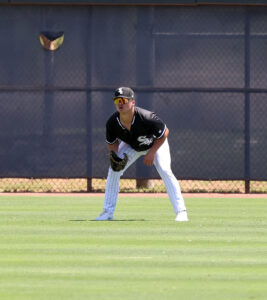Q&A with 4 pitchers and 2 coaches on the Intimidators
While visiting the three North Carolina affiliates of the White Sox, in addition to getting video and analyzing the prospects, we conducted interviews with players and coaches. Lots of them, in fact.
Below are some highlights from the conversations we had in Kannapolis with the Intimidators, specifically with pitchers, their pitching coach and manager (hitters and their coach coming soon). Get to know the hurlers and their captains in Kannapolis a little more personally…

Manager Justin Jirschele
FS: How did the coaching/managing path come up for you? How did the transition play out?
JJ: It was something I always thought about, as soon as I got to pro ball as a player. I knew my chances to get to the big leagues were slim. It just came up when I was done playing, in fact they asked me while I was playing to see if I wanted to take that leap and start right away. Those kind of opportunities don’t come up much for a guy who’s 25 and playing. To be able to get that start right away and get my foot in the door is pretty critical, so I thought that was a good opportunity that I couldn’t pass up.
FS: There is a balance in your role between team competitiveness – winning games – and player development, and sometimes decisions split based on which way you want to go. How do you balance those two objectives?
JJ: Obviously that’s a question that comes up a lot. But at the end of the day, I think that both player development and winning are tied together. I think winning is a part of development and a very crucial part. We can do so much to develop these guys, but when they get to the upper levels or even Chicago, they need to have some experience winning as well. I think it’s critical to development to get the individual side of the game off to the side for a second, and look at as a team, what [they] can do every single night for that team. Whether it’s getting on base, scoring a run, or making a crucial play in the field, I think that goes with getting these guys to the big leagues.
FS: What has surprised you most so far about being in the manager role, coming over from playing? Anything you weren’t expecting?
JJ: I wouldn’t say there was anything I wasn’t expecting. You have your hands on everything, your eyes on everything. Obviously growing up I was a position player, so I’m still learning a lot about pitching. I pick [Kannapolis Pitching Coach] Matt Zaleski’s brain every night and we talk about pitching stuff. It’s just learning. You’ve got to come out every day and be a sponge. If you can learn something new every day, at the end of the season you can look back and say it was a successful year for myself and my career, but also teaching these guys the things that I learn as well.
FS: Just for fun – who is the prankster in this clubhouse, if anyone?
JJ: Ooh, prankster. I wouldn’t say prankster, but I think Mike Morrison, one of our relievers has that playful side to him. He’s got jokes and comments – the boy is loose.

Pitching Coach Matt Zaleski
FS: Alec Hansen flourished last year under your coaching in Great Falls, what it like having him here again in Kannapolis?
MZ: Hansen and I have a very good chemistry and he’s opened up to me, but I’ve seen him open up to more people now. First year guy coming out of the draft, you get advice from your college coach and advice from other people and you aren’t sure who to listen to sometimes. He’s been great so far this year, buying into what we are having him do. He works hard.
FS: I saw his start last night and he was completely dominant in the first few innings and faded a bit in the 5th and 6th. What did you see change and what are you working on with Hansen?
MZ: He held his curveball through the first three and it was dominant. He lost feel for it right around half-way through the fourth and its something that I talked to him and Seby (Zavala) about, if you notice that pitch is starting to go, its not something you want to throw in a big situation. Looking at his velo chart, it only dropped like one MPH in the last three innings so it’s obviously not a conditioning factor. Crispness of his pitches may of dropped just a hair, but I thought his slider got better as the game went along, his change-up has made tremendous improvements from last yearand he has used it a bunch in his last start and the start before that. The more he gets comfortable and the more he gets into a routine of seeing whats working that day and realizing this pitch isn’t working today I may have it later, or I have this pitch right now and what is my plan if I end up losing that pitch. It didn’t look like they were barreling up a lot of fastballs and I talked to him about that, its good to have a mix of speeds, but if your fastball is that dominant, stay with it. Especially later in the game, you show them you have the off speed stuff early, that means they are going to protect on the offspeed. You can get those fastballs by them in the 5th and 6th.
FS: I noticed that in a big spot in the game he shook Seby off a couple times to throw his slider. Was that something you pointed out to him?
MZ: The other day I was crunching some numbers on Hansen, and he was like 75% strikes with his slider. So if you need a first pitch strike, or a big situation, full count, runners on, thats probably a pitch you can go with. He’s not a fastball-curveball guy anymore and thats all the credit to him.
FS: One of the most common things in these young pitchers is trying develop a change-up. Where is Alec at with that pitch?
MZ: We challenged Alec in instructs to improve his change-up and credit to him, he put the work in and improved. He had some starts where we made him go fastball-change-up and helped him get the feel for it. He came back into ST with a tremendous feel for it and pretty happy with the velo on it. It’s not 89-90 like it could be, but more around 83-86. As long he keeps his delivery tempo the same, I think hitters are going to have a lot of trouble squaring up.
FS: Flores has been pitching well with decreased velo this season, what has been he been doing well?
MZ: Commanding his fastball in-and-out, good angle, throws strikes with it and he has that plus change-up. Curveball is coming along, its big, trying to get him to throw that with the same intensity that he throws his fastball. When he does, the curveball is really good. Guys can get worried about their velo, but from all the years I’ve played, you see draft guys velo, starters anyway, come in and the first year its not where it was previously. We aren’t too concerned about that, he’s having the same success he had in Great Falls thanks to locating his fastball and using his change-up all the time.
FS: Jimmy Lambert has been pitching well this year, what can you tell me about him?
MZ: We are trying to get him to stay a little taller on his backside, when he stays tall he throws with tremendous angle. He added a two-seamer, something to give him more movement, he has movement on the four-seam but maybe in a 2-0 or 1-0 count he can get the two-seam to run a bit. He has induced a tremendous amount of ground balls, throws a ton of strikes, and to me he’s very similar to Dane Dunning. He has similar stuff, similar attack mentality on the mound, it just comes down to fastball location. Consistency with your fastball location moves you up in this game.
FS: I’m glad you brought up Dane, because he was so good here. Was that a product of his fastball command and overpowering hitters at this level?
MZ: Yeah absolutely. If I had to picky, he was maybe a touch better arm-side than he is opposite arm-side, better in to a righty than down and away to a righty on his fastball. He was at like 76% first pitch strike, 70% with his fastball, 68% with his slider, 60% with his curveball, 69% with his change-up, like he’s in the zone all the time. Thats why when you look up in the 6th, 7th, and 8th inning and his pitch count is only at 80 something pitches, well obviously. Stuff wise, when he told me he was in the bullpen in college, I was like, “how? You have four pitches! Four good one for strikes.”
FS: Mike Morrison has been absolutely lights out for you, what are you doing with him?
MZ: Mike we have done some work with trying to control the violence with his head, it seemed to have helped by getting him to stay tall. The command with his fastball, he’s actually throwing it downward with angle. It was funny because he made the comment, “Oh now I gotta learn to pitch by throwing my fastball down.” Because he used to throw his fastball up in college then just throw the breaking stuff, but now he sees he can throw the fastball down and he doesn’t have to be as perfect with the breaking ball because they look like the fastball going down. He’s been great for us, he even had an outing where he went three innings, 39 pitches, and in the zone with all his pitches. We need to work with him on his change-up, its tough during the season because you don’t want to send him out there for one inning and say, “throw six change-ups.”

RHP Alec Hansen
FS: Going back to the draft, did you have some idea of what might happen? What round you might be drafted, and if the White Sox were going to take you?
AH: Going in, I thought I would go higher than I did. But once I didn’t hear my name in the first round, I didn’t know what to think, I wasn’t sure I’d even get taken in the second round.
FS: Sticking with your college time, you had some struggles in your junior season with control. Since you’ve been in the White Sox organization though, you’ve been doing very well in that way. What has changed? What have you worked on to get there?
AH: To be honest, we’ve worked on a couple things, but I don’t think a lot has changed. I think looking at college, it was more my confidence – what’s changed is the confidence the coaching staff has in me here, allowing me to just pitch and work through trouble. Just that they had the confidence in me, and the players had confidence in me as well. I mean, you have to have confidence in me to take me in the 2nd round like that, after the season I had.
FS: What are you most confident in right now? What do you see as your biggest strength?
AH: Other people may not say this, but I’m really confident in my change-up. I haven’t been throwing it as hard as I did in college. I think I’ve really dialed it in, it’s really coming along good. Last night I threw quite a few, and no one has really hit it yet. I’ve gotten quite a few swings and misses on it.
FS: One moment from last night’s game, I saw you shake off Seby twice late in your start, after not shaking him off at all. You then threw a slider and got a strikeout to get out of a jam. Are you looking to throw that slider more often? Or was it just situational?
AH: On 3-2, right? Yeah I remember that. I used to throw my slider a lot more than my curveball. But I feel like my curveball plays better, and I can throw it for a strike more often, so I think it’s a better pitch than my slider. But my curveball’s not always there – my feel for it – and my slider I’ve usually got a pretty good feel for. So I just felt more comfortable going to the slider then, than the curve.
FS: About the running game. As you are learning how to pitch, it’s tough to also work on controlling the running game. But is there anything in particular you are working on, with Matt [Zaleski] or anyone else, to improve on that?
AH: Well, yeah. It’s not something we just blow off of course. I see that guys are stealing on me all the time. But right now, mostly, it’s just trying to tackle one thing at a time. I’m trying to get all my pitches down, throw a lot of strikes. Just focus on myself right now, and attacking hitters rather than the running game right now. Once I’ve completed those things that Im working on right now, if you know what I’m saying, then I’ll focus more on the running game.

RHP Bernardo Flores
FS: You were mostly a reliever in college at University of Southern California, what has the transition been like going from the bullpen to being a full-time starter with the White Sox?
BF: I was basically a week-to-week, whatever fits kind of guy. In high school I was a starter, so I have a familiarity with the role and then when I got to SC, I was more out of the bullpen. I don’t know what happened there, but I was a swingman or whatever role that was. But then the White Sox came in and saw me as a starter and I always believed in myself as a starter and have always enjoying starting.
FS: Did you have an idea the White Sox were interested in you in the draft process?
BF: I talked to my area scout, Kenny Williams Jr, and since day one he has been telling me everything straight up how things are going to be. When the draft came around, I got a few calls here and there but nothing set in stone. When the 7th round came, out of nowhere I got a call from Kenny I believe, and he said am I willing to go and I said yeah! Then within two picks the White Sox came up and sure enough it was me. I am very fortunate and very humbled and feel very blessed to be apart of the White Sox.
FS: I was here for your start yesterday and when I was charting your pitches I noticed your velo going up and down. Is that something you do intentionally to change speeds?
BF: To be honest with the velo fluctuations, I am still working on it but its something I do naturally. I don’t do it intentionally, its something that happened in college too. It may be down right now a little bit, the one important thing I remember, is pitch with whatever you got on any given day. You are not always going to be 100% and has everything on a certain day but still have to be able to pitch and put the ball in the mitt, on the corners, and get outs. When the velocity comes back it will be great but the main this is can you still pitch with whatever you got?
FS: Could you describe your repertoire for our readers and any particular pitch you are working on?
BF: I have three pitches, normal fastball, change-up, curveball, and I am still working on my two-seamer. Right now things are tough with my change-up, so I working with Coach Z in bullpens with that. I think from college, to last year, to this year my curveball has gotten way better. Still working on getting tighter spin and making it firmer. I’m also working on fastball command, putting it on either side of the plate.

RHP Jimmy Lambert
FS: What what it liked being drafted by the White Sox last year and did you have any idea the White Sox were interested?
JL: I filled out their questionnaire, but I hadn’t talked specifically to the White Sox, and I had talked to almost every other team. So when my agent texted me the offer from them in the 5th round, I was like “whoa the White Sox?” But obviously its a dream come true to be selected, regardless of where you get selected. I was definitely happy to go in the 5th round.
FS: Could you describe your repertoire for our readers?
JL: I have a four-seam and two-seam fastball that I split throwing about 50/50, four-seam can probably get up (in velocity) a little more than the two-seam. I’ve got a slider, a curveball, and a change-up that I’ve been throwing a lot more this year than I have in the past.
FS: Your pitching coach was mentioning how he was working on you staying tall and pitching downhill. How have you been implementing that?
JL: My college coach was very similar in his mindset and philosophies to what the White Sox are. So it was a good transition because it was a lot of the same stuff. “Stay tall, stay back, and throw downhill.” I’ve been working with coach Z (Matt Zaleski) on staying tall quite a bit and not cutting myself off to get the ball going downhill to get ground balls. If you get ground balls you give yourself a chance.
FS: How many change-ups do you typical throw in an outing?
JL: Definitely been throwing more change-ups than I ever have before, I’d say I threw between 10-15 change-ups last game. Maybe a little less sliders and a little bit less curveballs, so I’ve been using change-up most among the breaking balls, but I am predominantly working my two fastballs.
FS: You have a younger brother (Peter Lambert) in the Colorado Rockies organization who was drafted a year before you in 2015. How much help has it been having a brother going through the draft process and becoming a pro?
JL: Basically having gone through the whole process in 2015 for him, you just know what to expect going into it. It felt like I had already gone through it in a way, once I got selected and became a White Sox we talk quite a bit. He’s one of my best friends so I knew I have someone I could talk to about pro baseball and what to expect in Low-A.

RHP Mike Morrison
FS: You started your pro career a little late last year, because you were busy winning a college championship with Coastal Carolina. Now obviously this could have a very long answer, but can you give us a brief idea of what that experience was like?
MM: It was awesome. The amount of pressure pitches I threw in the last month and a half of the season; it was one or two runs, and every situation felt like a big situation where I couldn’t let all my buddies down. Not saying it’s been easy here, but those end of game situations I’ve always enjoyed. And doing all that has made me a lot more comfortable in those situations.
FS: So you think that’s been helpful in dealing with pressure?
MM: Oh yeah. I mean, last year I went from pitching in front of thirty thousand in Omaha, to like eight hundred here. Of course now you’re playing for a career, so it’s a little different, but yeah it helps.
FS: Since we, and most of our readers, haven’t seen you pitch and don’t know much about you yet, can you tell us what about your pitch repertoire?
MM: I throw a lot of curveballs and sliders. My fastball command has gotten a lot better in the last year. I’ll show fastball, then go breaking ball, or sometimes open with my slider. My thought is if they see one, you expect one, but get another, you get a lot of swings and misses at this level so I like to mix it up. I’ve worked on a change-up a little bit. But mostly, it’s the ninth inning, I’ll dump in a breaking ball early because they’re not going to be sitting first pitch breaking ball in that situation. It’s a three-pitch mix, and my fastball has gotten a lot better so I can lean on that when I don’t have those other pitches working.
FS: What are you hoping to improve on this year?
MM: Fastball command to my glove side has always been a problem for me. I do a very good job pitching in, but pitching away or down and away has been something else. In college I got away with throwing it off the zone because my curveball works off that. But at this level you have to be able to get that pitch away, which I’ve gotten a lot better with this year compared to last year.
Want to know right away when we publish a new article? Type your email address in the box on the right-side bar (or at the bottom, if on a mobile device) and click the “create subscription” button. Our list is completely spam free, and you can opt out at any time.






